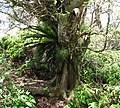Fichier:Bobea elatior (4743751500).jpg

Fichier d’origine (1 887 × 1 692 pixels, taille du fichier : 1,06 Mio, type MIME : image/jpeg)
Ce fichier et sa description proviennent de Wikimedia Commons.
Description
| DescriptionBobea elatior (4743751500).jpg |
ʻAhakea lau nui Rubiaceae Hawaiian endemic genus Kalauao Trail, Koʻolau Mts., Oʻahu Two indigenous ephiphytes on the tree: ʻēkaha (Asplenium nidus), flat-stemmed whiskfern or moa nahele (Psilotum complanatum) can be seen in the tree. Early Hawaiians had many uses for ʻahakea. It was used for canoe (waʻa) construction, the hard yellowish or reddish wood of ʻahakea was the most favorite wood for making gunwales strakes (moʻo), the forward end piece (lāʻau ihu), and the aft piece (lāʻau hope). Canoe paddles were also made from ʻahakea wood. It was also the preferred to frame hale (house) doorways and door frames (lapauila) because the reddish or yellowish colored wood was a chiefly color. Poi boards (papa kuʻi poi) were made from ʻahakea because its close grained wood. ʻAhakea, mixed with kukui nuts, was also used medicinally to help with abseces, burst sores (ʻili pūhō); scar, perhaps tuberculosis; (ʻalaʻala); and itch, ulcer (meʻeau). The bark and leaves were boiled and used to bathe in. Medicinally, moa (Psilotum spp.) was used byt he early Hawaiians for kūkae paʻa (constipation) in newborn babies and elderly men and women. It was also mixed with other plants to treat akepau (tuberculosis, consumption), and various respiratory conditions. Additionally, extracts from moa were used as laxatives. The spores were used for diarrhea in infants and used like talcum powder to prevent chafing from loincloths. Moa was also used in lei making by early Hawaiians. Early Hawaiian children would play a simple game of moa nahele (lit., chicken vegetation). Plants in Hawaiian Culture explains how this game was played: “Two children sat or stood facing one another, each holding a branched stem of moa. These they interlocked and then slowly pulled apart until the branches of one broke. The other child, without broken branches, was the winner and announced his victory by crowing like a rooster (moa).” One of the names ʻoʻō moa in fact means "cock's crow." nativeplants.hawaii.edu/plant/view/Bobea_elatior |
| Date | |
| Source |
|
| Auteur | David Eickhoff from Pearl City, Hawaii, USA |
Conditions d’utilisation
- Vous êtes libre :
- de partager – de copier, distribuer et transmettre cette œuvre
- d’adapter – de modifier cette œuvre
- Sous les conditions suivantes :
- paternité – Vous devez donner les informations appropriées concernant l'auteur, fournir un lien vers la licence et indiquer si des modifications ont été faites. Vous pouvez faire cela par tout moyen raisonnable, mais en aucune façon suggérant que l’auteur vous soutient ou approuve l’utilisation que vous en faites.
| Cette image, qui provient de Flickr, a été vérifiée le 15 novembre 2012 par l'administrateur ou l'utilisateur de confiance (trusted user) File Upload Bot (Magnus Manske), qui a confirmé qu'à cette date, elle était publiée sur Flickr sous cette licence. |
Légendes
Éléments décrits dans ce fichier
dépeint
Valeur sans élément de Wikidata
Canon PowerShot G3 anglais
19 août 2004
0,005 seconde
7,2 millimètre
image/jpeg
6212cdc5ffcfc0eee3fe45d911dc0efa721f8bb4
1 108 940 octet
1 692 pixel
1 887 pixel
Historique du fichier
Cliquer sur une date et heure pour voir le fichier tel qu'il était à ce moment-là.
| Date et heure | Vignette | Dimensions | Utilisateur | Commentaire | |
|---|---|---|---|---|---|
| actuel | 15 novembre 2012 à 09:14 |  | 1 887 × 1 692 (1,06 Mio) | File Upload Bot (Magnus Manske) | Transferred from Flickr by User:Tim1357 |
Utilisation du fichier
La page suivante utilise ce fichier :
Usage global du fichier
Les autres wikis suivants utilisent ce fichier :
Métadonnées
Ce fichier contient des informations supplémentaires, probablement ajoutées par l'appareil photo numérique ou le numériseur utilisé pour le créer.
Si le fichier a été modifié depuis son état original, certains détails peuvent ne pas refléter entièrement l'image modifiée.
| Fabricant de l’appareil photo | Canon |
|---|---|
| Modèle de l’appareil photo | Canon PowerShot G3 |
| Résolution horizontale | 180 pt/po |
| Résolution verticale | 180 pt/po |
| Logiciel utilisé | picnik.com |
| Date de modification du fichier | 19 août 2004 à 23:51 |
| Positionnement YCbCr | Centré |
| Durée d’exposition | 1/200 s (0,005 s) |
| Ouverture focale | f / 8 |
| Version d’EXIF | 2.2 |
| Date et heure de génération des données | 19 août 2004 à 23:51 |
| Date et heure de la numérisation | 19 août 2004 à 23:51 |
| Signification de chaque composante |
|
| Vitesse d’obturation APEX | 7,6582115219261 |
| Ouverture APEX | 6 |
| Biais de compensation d’exposition APEX | 0 |
| Ouverture maximale interne de la lentille | 2 APEX (f / 2) |
| Mode de mesure | Motif géométrique |
| Flash | Flash non déclenché, suppression du flash obligatoire |
| Longueur focale de la lentille | 7,2 mm |
| Version de FlashPix prise en charge | 1 |
| Espace colorimétrique | sRGB |
| Résolution horizontale du plan focal | 8 114,2857142857 |
| Résolution verticale du plan focal | 8 114,2857142857 |
| Unité de résolution du plan focal | pouces |
| Type de capteur | Capteur de couleur à une puce |
| Source du fichier | Appareil photo numérique |
| Rendu d’image personnalisé | Procédé normal |
| Mode d’exposition | Exposition automatique |
| Balance des blancs | Balance des blancs automatique |
| Taux de zoom numérique | 1 |
| Type de capture de la scène | Standard |